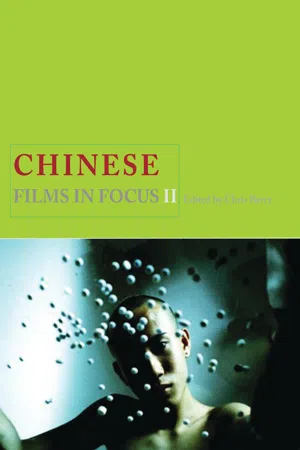
- 304 pages
- English
- ePUB (mobile friendly)
- Available on iOS & Android
Chinese Films in Focus II
About this book
Chinese cinema continues to go from strength to strength. After art-househits like Chen Kaige's Yellow Earth (1984) and Wong Kar-wai's In the Mood for Love(2000), the Oscar-winning success ofAng Lee's Crouching Tiger Hidden Dragon (2000) disproved the old myth that subtitled films could not succeed at the multiplex. Chinese Films in FocusII updates and expandsthe originalChinese Films in Focus: 25 New Takes with fourteen brand new essays, to offerthirty-fourfresh and insightful readings of key individual films.The new editionaddresses films from mainland China, Taiwan, Hong Kong and other parts of the Chinesediaspora and the historical coverage ranges from the 1930s to the present. The essays, by leading authoritieson Chinese cinema as well as up-and-coming scholars, are concise, accessible, rich, and on the cutting edge of current research. Eachcontributor outlines existing writing and presents an original perspective on the film, making this volume a rich resource for classroom use, scholarly research and general reading for anyone wanting to understand more about the historical development andrich variety of Chinese cinema. Contributors: Annette Aw, Chris Berry, Yomi Braester, Felicia Chan, Esther Cheung, Robert Chi, Rey Chow, Mary Farquhar, Carolyn FitzGerald, Ping Fu, Kristine Harris, Margaret Hillenbrand, Brian Hu, Tan See Kam, Haiyan Lee, VivianLee, Helen Hok-Sze Leung, David Leiwei Li, Song Hwee Lim, Kam Louie, Fran Martin, Jason McGrath, Corrado Neri, Jonathan Noble, Beremoce Reynaud, Cui Shuqin, Julian Stringer, Janice Tong, Yiman Wang, Faye Hui Xiao, Gang Gary Xu, Audrey Yue, Yingjin Zhang, John Zou The Editor: Chris Berry is Professor of Film and Television at Goldsmiths, University of London.
Frequently asked questions
- Essential is ideal for learners and professionals who enjoy exploring a wide range of subjects. Access the Essential Library with 800,000+ trusted titles and best-sellers across business, personal growth, and the humanities. Includes unlimited reading time and Standard Read Aloud voice.
- Complete: Perfect for advanced learners and researchers needing full, unrestricted access. Unlock 1.4M+ books across hundreds of subjects, including academic and specialized titles. The Complete Plan also includes advanced features like Premium Read Aloud and Research Assistant.
Please note we cannot support devices running on iOS 13 and Android 7 or earlier. Learn more about using the app.
Information

Table of contents
- Cover
- Title Page
- Contents
- Notes on Contributors
- Introduction: One Film at a Time – Again
- 1. 15: The Singapore Failure Story, ‘Slanged Up’
- 2. Big Shot’s Funeral: Performing a Post-modern Cinema of Attractions
- 3. Black Cannon Incident: Countering the Counter-espionage Fantasy
- 4. Blind Shaft: Performing the ‘Underground’ on and beyond the Screen
- 5. Boat People: Second Thoughts on Text and Context
- 6. Centre Stage: A Shadow in Reverse
- 7. A Chinese Ghost Story: Ghostly Counsel and Innocent Man
- 8. Chungking Express: Time and its Displacements
- 9. Crouching Tiger, Hidden Dragon: Cultural Migrancy and Translatability
- 10. Crows and Sparrows: Allegory on a Historical Threshold
- 11. Durian Durian: Defamiliarisation of the ‘Real’
- 12. Ermo: (Tele)Visualising Urban/ Rural Transformation
- 13. Farewell My Concubine: National Myth and City Memories
- 14. Flowers of Shanghai: Visualising Ellipses and (Colonial) Absence
- 15. Formula 17 : Mainstream in the Margins
- 16. The Goddess: Fallen Woman of Shanghai
- 17. Hero: The Return of a Traditional Masculine Ideal in China
- 18. In the Mood for Love: Intersections of Hong Kong Modernity
- 19. Kekexili: Mountain Patrol: Moral Dilemma and a Man with a Camera
- 20. The Love Eterne: Almost a (Heterosexual) Love Story
- 21. Not One Less: The Fable of a Migration
- 22. The Personals: Backward Glances, Knowing Looks and the Voyeur Film
- 23. PTU: Re-mapping the Cosmopolitan Crime Zone
- 24. The Red Detachment of Women: Resenting, Regendering, Remembering
- 25. Riding Alone for Thousands of Miles: Redeeming the Father by Way of Japan?
- 26. Spring in a Small Town: Gazing at Ruins
- 27. A Time to Live, A Time to Die: A Time to Grow
- 28. A Touch of Zen: Action in Martial Arts Movies
- 29. Vive L’Amour: Eloquent Emptiness
- 30. Wedding Banquet: A Family (Melodrama) Affair
- 31. Woman, Demon, Human: The Spectral Journey Home
- 32. Xiao Wu: Watching Time Go By
- 33. Yellow Earth: Hesitant Apprenticeship and Bitter Agency
- 34. Yi Yi: Reflections on Reflexive Modernity in Taiwan
- Chinese Names
- Chinese Film Titles
- Index
- List of Illustrations
- eCopyright